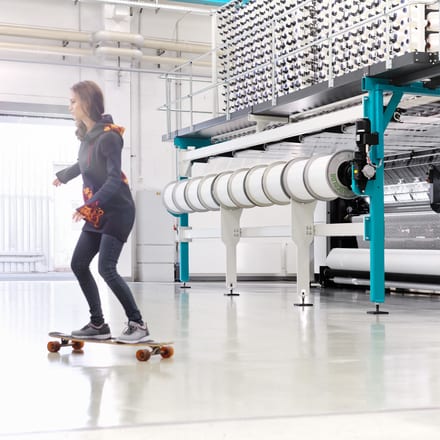Speed up production of TongDe Knitting
From KARL MAYER chain link lace machine to LACE.EXPRESS, FuJian TongDe Knitting Co. Ltd
In 2003 FuJian TongDe Knitting Co. Ltd purchased their very first chain link lace machine for producing lace bands. By 2011, they had gradually expanded their lace production capacity to a total of 37 sets of various types of KARL MAYER lace machines.
In late 2012, when the lace business was booming, Mr. Chen Guang Cheng, the managing director of FuJian TongDe Knitting Co. Ltd, decided to upgrade their production line by investing in KARL MAYER 134” MJ59/1B High Performance Jacquard Lace machines and at the same time they successfully sold most of the old generation KARL MAYER SU lace machines.
In 2014, when no one could imagine that the allover lace would become so fashionable as it is today, Mr. Chen Guang Cheng made a prudent decision to step into this new field, producing allover lace incorporating Bourdon yarns. As a result of intensive development in Designing, Draughting, Yarn qualities and machine settings combined with the right machine, allover lace finally became a new “highlight” in the market.
At the end of 2016, KARL MAYER launched the first LACE.EXPRESS machine, OJ 59/1 B, 210", a wider lace machine for the production of Allover Laces. That was the machine Mr. Chen Guang Cheng requested from KARL MAYER for a long time. Since the machine was introduced, he has shown confidence in the machine and has steadily placed orders for a total 20 machines.
In 2017, the production capacity from TongDe Knitting has reached 400 tons per month. The massive innovative output from their large R&D team has made TongDe Knitting become one of the leading manufacturers in the commodity sector for Allover Lace.
Why LACE.EXPRESS?
The main reasons for choosing KARL MAYER machine was high production rate combined with operational stability and reliability of the machine. We can learn directly from the experience of TongDe Knitting by comparing the performance statistic of the KARL MAYER OJ 59/1 B, 210", and a locally manufactured lace machine from the competition.
In a direct comparison between the OJ 59/1 B 210" and 268" locally manufactured lace machine, the output from both machine types is in the range of 10-13 tons (The production output can also be higher than this depending on the article being produced).
Considering those strong figures on KARL MAYER OJ 59/1 B, 210", is as below:
- The KARL MAYER Machine can run at a steady high speed of 900 rpm for actual production when using good quality yarns, prepared correctly for the machine and with the right settings.
- This in turn gives stable quality with less material wastage and second quality.
- 210" machine has a smaller footprint and uses less floor space than a 268" machines and lowers the air conditioning requirements which helps lower the production cost.
- A more stable running machine requires less operators to look after the workshop reducing the total operating cost.
We can learn why Mr. Chen Guang Cheng chose LACE.EXPRESS!
A further brilliant idea from TongDe Knitting was to connect the operating platforms of all machines to a closed construction. This makes it easier to load the high level creels for all the machines in the whole workshop using a dedicated team of workers. The Lace Machine operator only has to look after the knitting area. By separating the function of machine operation and Yarn loading, there is a great increase in efficiency for the whole workshop which helps to bring down the manufacturing cost.
Sad but true!
In 2014, the focus of TongDe Knitting was on the allover market, they knew the wider machine would be more suitable for supplying fabrics to the allover market. However, KARL MAYER only launched LACE.EXPRESS in 2016. To cope with the immediate need in the early days of this rising market, TongDe Knitting had to purchase a few sets locally made 3-panel and 4-panel Lace machines for trial use.
With the benefit received from using the OJ 59/1 B, 210", Mr. Chen Guang Cheng sold the locally made lace machines from the competition very quickly, replacing them with KARL MAYER machines. With the locally made machines, he learned that there are many mechanical problems with these machines which occurred frequently and totally at random. There were many defects on the fabric produced on the locally made machines, the root causes of which were not always possible to eliminate making it difficult to improve the fabric quality to the required level.
The downtime for changing pattern is also significantly longer on the locally made machines with increased fabric losses due to problems with getting the patterns to run right, this is different to the experience with KARL MAYER machine where pattern changes can be done quickly and efficiently enabling the KARL MAYER machines to produce good quality fabric after the pattern change.
Back to overview
